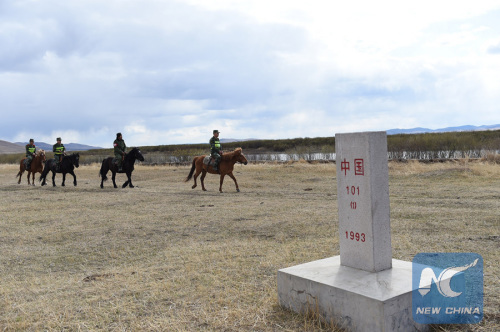
Photo taken on May 9, 2015 shows the Chinese side of the China-Russia border. (Xinhua/Shao Kun)
The "Shanghai Five," a mechanism that has successfully settled disputes and maintained the tranquility of border areas among participating nations, serves as a model for similar issues, experts said Wednesday.
The experts made the remarks at a two-day symposium commemorating the 20th anniversary of the signing of the historical Agreement on Confidence-Building in the Military Field in Border Areas Between China, Russia, Kazakhstan, Kyrgyzstan and Tajikistan in Shanghai on April 26, 1996.
The agreement stipulates that military forces of the five countries should not attack each other, should not conduct exercises aimed at each other, but inform each other of the scope of their exercises and set up friendly ties.
This agreement marked the beginning of the settlement of the border line that stretches over 7,000 kilometers, a process which was further accelerated by another accord -- the Agreement on Mutual Reduction of Military Forces in Border Areas between China, Russia, Kazakhstan, Kyrgyzstan and Tajikistan, which was signed in Moscow on April 24, 1997.
"The two agreements are unprecedented, which turned the once conflicting border areas into peaceful ones that even serve as a bond of friendship between bordering countries," said Erik Ashimov, Kazakhstan's permanent delegate to the Secretariat of the Shanghai Cooperation Organization (SCO).
The Shanghai Spirit, marked by mutual trust, mutual benefit, equality, consultation, respect for diverse civilizations and shared development, not only laid the foundation for the "Shanghai Five" mechanism, but also serves as the core value for the later developed SCO.
"Under such a spirit, China has resolved the boundary disputes with 12 out of 14 bordering states. We signed 29 treaties over border settlement and confirmed the land borderline of over 20,000 kilometers, which accounts for 90 percent of China's total land borderline," Chinese Vice Foreign Minister Liu Zhenmin said.
"It is the commitment and devotedness from all participating countries to solve conflicts through negotiation and dialogues that have led to the successful result," said Sheng Shiliang, a researcher at the Xinhua Center for World Affairs Studies.
The peaceful settlement of the border issues among the five nations has demonstrated that negotiation and dialogue work well as long as relevant countries harbor the sincerity to put an end to tensions.
Sheng's remarks were echoed by Evgeny Tomikhin, minister counselor at the Russian Embassy in Beijing, who highlighted mutual trust and mutual benefit by saying, "We should look after the interests of others as well as ours."
Starting as a forum aimed at reducing hostility along the border lines, the mechanism has turned out to be a new niche for regional cooperation in the political, security, law enforcement and economic areas.
For example, in order to strengthen mutual support in safeguarding national unity and sovereignty and resist all kinds of threats to the security of the region, the "Shanghai Five" group has agreed that their defense ministers should meet on an annual basis and their militaries should be more active in conducting joint exercises and training, exchanging information about peacekeeping operations, and holding conferences and other exchanges.
Following the meetings in 1996 and 1997, subsequent annual summits of the "Shanghai Five" group were held in Kazakhstan's Almaty in 1998, in Kyrgyzstan's Bishkek in 1999, and in Tajikistan's Dushanbe in 2000.
At the Dushanbe summit, members agreed to "oppose intervention in other countries' internal affairs on the pretexts of 'humanitarianism' and 'protecting human rights,' and support the efforts of one another in safeguarding the five countries' national independence, sovereignty, territorial integrity, and social stability."
In 2001, the annual summit returned to Shanghai, where the five member nations first included Uzbekistan in the "Shanghai Five" mechanism. In June, the six countries adopted the Declaration of the SCO, making the "Shanghai Five" mechanism attain a higher level of international cooperation.
Over the past 20 years, cooperation between the "Shanghai Five" nations has spanned from security to a broad spectrum of areas such as trade, economy, and international and regional issues of common concern.
According to Wang Wenli, counselor at the Department of Boundary and Ocean Affairs of China's Foreign Ministry, China has signed many treaties with its four neighbors agreeing to open 103 pairs of ports, among which 74 pairs have already been opened.
"We built many such cross-border facilities as highways, railroads, bridges, oil and gas pipelines, and transmission lines. Besides, many border and cross-border economic cooperative zones are playing a vital role in promoting the business ties between the neighboring nations and elevating the living standards of the people living in those areas," Wang said.
Thanks to the "Shanghai Five" mechanism, the once highly guarded fronts which used to be wild places have been turned into economic and trade cooperation hubs featuring friendly communication and deepened mutual understanding.


















































